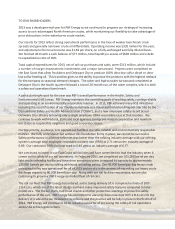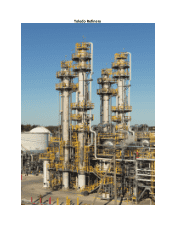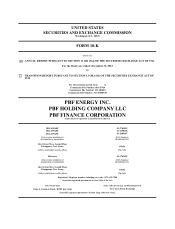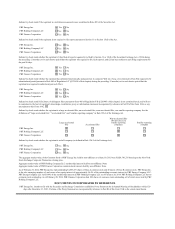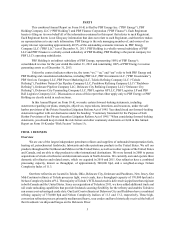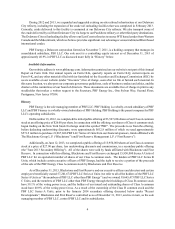PBF Energy 2013 Annual Report Download - page 14
Download and view the complete annual report
Please find page 14 of the 2013 PBF Energy annual report below. You can navigate through the pages in the report by either clicking on the pages listed below, or by using the keyword search tool below to find specific information within the annual report.
7
capability up to 210,000 bpd by the end of 2014, subject to the delivery of coiled and insulated railcars, the
development of crude rail loading infrastructure in Canada and the use of unit trains.
We have entered into agreements to lease or purchase a total of 5,900 railcars, including 4,600 coiled and
insulated rails cars, which are capable of transporting Canadian heavy crude oils, and 1,300 general purpose cars,
which we intend to use to transport lighter crude oils. In addition to the construction of our rail unloading facilities
at Delaware City and the execution of our railcar procurement strategy, we also created dedicated crude-by-rail
acquisition and rail logistics teams. These teams, staffed by PBF employees in our corporate headquarters, at the
Delaware City refinery and in our field offices in Calgary, Alberta and Oklahoma City, Oklahoma, are responsible
for crude procurement, logistics via rail and monitoring crude-by-rail offloading.
Overview. The Delaware City refinery is located on a 5,000-acre site, with access to waterborne cargoes
and an extensive distribution network of pipelines, barges and tankers, truck and rail. Delaware City is a fully
integrated operation that receives crude via rail at the crude unloading facility, or ship or barge at its docks located
on the Delaware River. The crude and other feedstocks are transported, via pipes, to an extensive tank farm where
they are stored until processing. In addition, there is a 17-bay, 50,000 bpd capacity truck loading rack located
adjacent to the refinery and a 23-mile interstate pipeline that are used to distribute clean products.
The Delaware City refinery has a throughput capacity of 190,000 bpd and a Nelson Complexity Index of
11.3. As a result of its configuration and process units, Delaware City has the capability of processing a slate of
heavy crudes with a high concentration of high sulfur crudes and is one of the largest and most complex refineries
on the East Coast. The Delaware City refinery is one of two heavy crude coking refineries, the other being Paulsboro,
on the East Coast of the United States with coking capacity equal to approximately 25% of crude capacity.
The Delaware City refinery processes a variety of medium to heavy, sour crude oils. The refinery has large
conversion capacity with its 82,000 bpd FCC unit, 47,000 bpd FCU and 18,000 bpd hydrocracking unit with
vacuum distillation. Hydrogen is provided via the refinery’s steam methane reformer and continuous catalytic
reformer.
Delaware City Process Flow Diagram
Naphtha
Kerosene
Di l
Naptha
Tetra feed Benzene
CCR
Tetra
Extraction
ULSD
BB
Diesel
Reformate
Crude
Distillation
Hydrotreaters
Coker
Middle
Distillate
Crude
Heating Oil
B-B
Isobutane
ATB
Gas oil Butane
Gasoline
ISOM
Poly
Alky
FCC
(Sales)
Gas oil
Light
Cycle Oil
P-P
Slurry
Gas oil Gasoline
Naphtha to HDS
Vacuum
Distillation
CNHTU
SHU
(Sales)
Heavy
Cycle Oil
Gas oil
VTB
Naphtha to HDS
Naphtha
Fluid Coker
Diesel
SHU
Hydrocracker
Gas Oil
Coke


